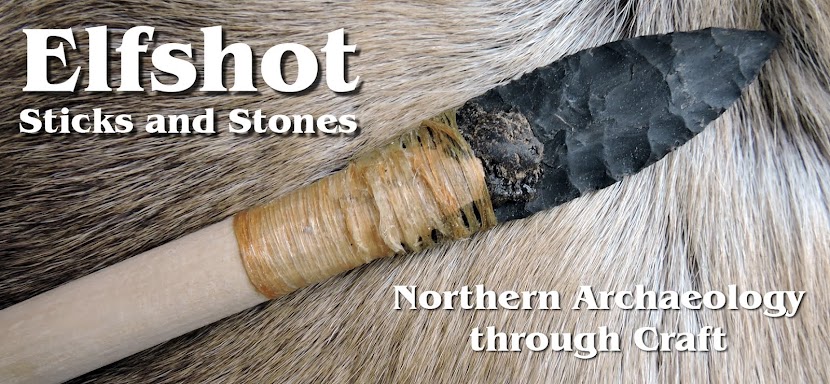 |
| Beothuk Harpoon head and arrowheads, The Rooms |
I'm still away on the trip to the west coast. If everything went according to plan, then the Craft Council AGM wrapped up yesterday and I'm collecting stone and wood on the drive home today and tomorrow. I'm tempted to stop in at the Mary March Museum in Grand Falls-Windsor, as well. They have an excellent display of Beothuk artifacts and there are a couple of things about the spears and harpoon heads that I'm curious about.
 |
| Shawnadithit's drawing of hunting weapons |
I mentioned this idea before in the comments of
an earlier post, but I think that the Beothuk may have used their long deer spears as the mainshaft and foreshaft for their sealing harpoons. Shawnadithit drew pictures of the the deer spear and sealing harpoon side-by-side, and doesn't give any indication that they may have occasionally been the same instrument, but the existing Beothuk harpoon heads look as though they were designed to fit onto extremely flat and wide foreshafts. Which is odd, because Shawnadithit doesn't draw a foreshaft at all on her harpoon. I've posted the photos that I have on hand of the Beothuk harpoon head in the Mary March Museum and the one on display at the Rooms in St. John's (the one at the top of the post). I wasn't really thinking about the sockets when I took these photos, so I don't have any that show quite how wide and flat these sockets are, but I think they give you the general idea. I have an especially hard time imagining a wood shaft that would fit into these harpoon heads. In order to fit inside, it would have to taper down to a spatula end about the thickness of a credit card.
 |
| Beothuk Harpoon head in the Mary March Museum - also has a extremely thin, flat socket at the base |
 |
| The harpoon head could fit onto the end of one of the larger iron spearheads |
 |
| What is that binding material - why is it black? |
In looking at these photos, I'm also curious about the binding material on the harpoon head with the iron endblade intact. The binding is identified as sinew, but sinew isn't black. Either the discolouration came from the treatment of the iron endblade, or it may be black pitch that was used as a glue. There are so few examples of hafted Beothuk tools (in fact, this may be the only one) that it would be very interesting to examine the binding in a little more detail.
Photo Credits:
1,3-5: Tim Rast
2: Drawing by Shawnadithit from
Newfoundland and Labrador Heritage website






Is it possible an iron arrowhead/spear was used as a foreshaft - maybe not. That probably would have split the harpoon?
ReplyDeleteYes, that's what I was thinking - that the harpoon heads were designed to fit over the iron blade of a spear. The potential for splitting is the biggest downside that I can think of as well. I saw the artifacts today and the slot in the base of the harpoon head is so narrow, that some of the larger iron spears might not even fit inside. Someday I'll make one and try it out on wood and iron foreshafts.
ReplyDelete